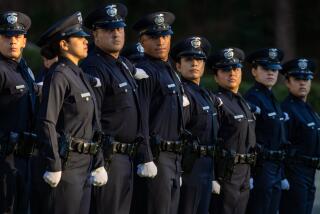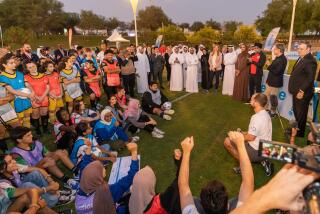Training for Peace in the Midst of War : Is a group of civilians learning to mediate conflicts engaging in a historic experiment or an exercise in futility?
- Share via
SCHLAINING, Austria — Tucked away in a bucolic corner of Central Europe, this tiny village is better known for its 700-year-old castle than for training people from around the world for peace. Just minutes away from the Hungarian border, Schlaining is surrounded by lush, rolling hills that used to be called the “Iron Curtain.” It is the kind of village where locals greet you with “Gruss Gott” and church bells ring every 15 minutes, day and night, lest you forget to which power you must eventually submit.
Carefully folded into this village is the Austrian Study Center for Peace and Conflict Resolution, where 25 men and women from 15 countries are going through the first formal training in civilian peacekeeping.
The idea, unthinkable during the Cold War, is that the United Nations and other international agencies will develop a roster of civilians trained in conflict resolution. These people could be sent anywhere, with or without the United Nations’ “blue helmets,” to help mediate ethnic strife, border clashes, civil conflicts or political disputes before violence erupts.
As I watch them train, I try to decide if they are engaged in a historic experiment or a naive exercise in futility.
Some of the people participating in this program are diplomats; others are intrepid peace activists from non-governmental organizations such as Amnesty International or the Helsinki Citizens’ Assembly. A few are Austrian conscientious objectors who will spend a year in Croatia, rebuilding schools and homes as alternative duty.
These future peacekeepers practice for every conceivable post-Cold War scenario. They learn preventive diplomacy, peacekeeping in the midst of war and post-conflict peace-building--all of which U.N. Secretary General Boutros Boutros-Ghali called for in his “Agenda for Peace.” Through simulation and role-playing, they drill in mediation, negotiation and conflict resolution. They learn how to monitor human-rights violations. They know their work will be dangerous; they prepare for arrest, imprisonment, even torture.
One day, I watch a novice peace diplomat try to mediate an imaginary conflict between two warlords. Another trainee attempts to negotiate a truce in a village divided for centuries by ethnic hatred. Sometimes, the participants become so engrossed, they get carried away. One man, furious at students who have thrown stones at him, rolls up his pants to show his wounds to the mediator. He is surprised to find that he is unharmed.
I ask people in the program what they expect to take away from this intensive training. A man from Brazil says he expects to train others in his country, where the idea of conflict resolution is largely unknown. A woman from Croatia tells me she will return to Pakrac, a town at present divided between Serbian and Croatian rule, to work with a U.N. resettlement and reconciliation project. An Austrian diplomat has already left for a peace mission to Haiti.
While civilians train for peacekeeping, 35 students from 25 nations study at the European University of Peace Studies, the academic arm of the Austrian Study Center in Schlaining. In the seminar I teach, 12 students, mostly from Third World countries, try to understand each other’s heavily accented English as they debate the impact of different kinds of economic development on their cultures. I don’t think they believe that I am learning more than I am teaching.
In the evening, participants in the civilian peacekeeping program, along with students and faculty, huddle around the television and watch CNN’s coverage of civil wars raging around the globe. The spread of civilian and military violence, from Moscow to Sri Lanka, often makes all the activity going on in this village seem irrelevant, even frivolous.
But perhaps peace must be measured in the small gestures people make to understand each other: A German feminist and Islamic fundamentalist find common ground; a Pakistani comforts an Indian who has just learned of the earthquake.
With the war in Bosnia just a few hours’ drive away, maybe it is sufficient that a community of people from vastly different backgrounds have learned to live together and resolve their cultural differences without conflict. And maybe someone here is learning skills that will one day make a difference.
Peace, after all, is not merely the absence of war.
More to Read
Sign up for Essential California
The most important California stories and recommendations in your inbox every morning.
You may occasionally receive promotional content from the Los Angeles Times.













